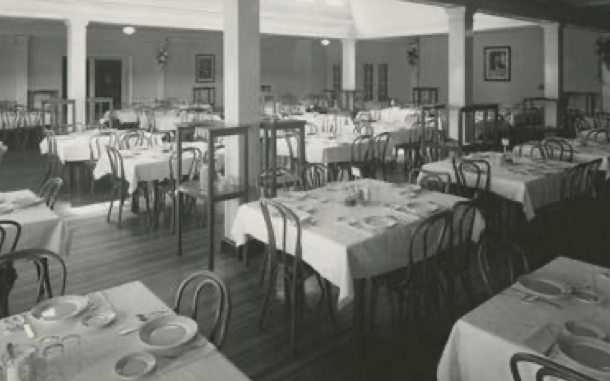
Evan Stinson (evstinson@ursinus.edu)
Every day most students step into Wismer’s Upper or Lower, to the buffet or the kiosks, without much thought. This is where dining services are and so it’s the easiest and quickest place to get a meal. Through the pandemic, dining services have been challenged with keeping services running, as Director Mike Forstoffer stated in Chase Portarto’s op-ed in the Grizzly’s most recent edition. The department has lost staff, and added styrofoam items to its annual budget. Uncertainties about dishwashing staff have produced a “red-light, green-light” play between styrofoam and ceramic utensils. In these moments of disruption, it may be time to reflect back on changes and consistency across the span of the Ursinus College’s dining services history.
Ursinus opened its doors in 1869 to the first class of students in buildings formerly used by Todd’s School, a one-room grammar school, and Freeland Seminary, a German Reformed church school. The Seminary would operate as a department through the early years of the college, but regulations around to inform prospective families, Founder and President John Bomberger in 1872 wrote a description of the school’s day-to-day activities later quoted in Alumnus Calvin D. Yost’s Ursinus College: A History of its First Hundred Years. According to Bomberger, the original dining hall layout was two long tables with bench seating, and professors sat at the end of each table. In roughly twenty minutes, all were finished eating and were “dismissed in order by a stroke of the tap-bell” (18). Much of early student life was run in this ordered way, and would remain the case in some respects until the 1960s-70s.
As the school grew into the 1880s-90s, it became clear these accommodations were not going to be able to serve all students. Students began forming “Eating Clubs” where they might cook and have dinner with one another to make up for this deficiency. By the early 1900s, it was clear that something had to give. Renovation and new dining hall plans were drawn up in 1910 and then initiated three years later under the recently elected President George Leslie Omwake. The renovations took until December 1913, and saw actual plumbing installed at the College. The dining services functioned as a sit-down restaurant with a full wait staff. This upgraded dining space included the Lower levels and Upper level of Freeland Hall, a white stately building of the former seminary where Myrin now sits. Including the dorms, this former hall was called Freeland-Derr-Stine, a format still present in our freshman dorms. Photographs show white clothes, forks, knives, spoons, and plates spread out across every table. Waiters dressed in white suits standing at the edges of thick square columns. The later upper addition appeared to have thinner columns and a set of windows acting as a skylight.
Freeland Hall as the center of dining services lasted until 1964, when the construction of Wismer Hall began as a modern, expanded spot for eating and administration on campus. The new cylindrical building was completed in 1965 with alumni support. An article in the Winter 1965 Alumni Bulletin stated, “‘It is not one building but many, and all of them together make a profound and permanent difference. It pleases the senses and stimulates the mind in a new way” (19). At this time, the design was said to have “a quickening effect on student waiters and waitresses as they make their pre meal preparations” (20). Freeland-Derr-Stine was soon demolished in 1968 for the construction of Myrin Library, as Wismer and the “New Dormitory” (Yost 187)—now Reimert—took its place.
Nearly ten years after Wismer’s grand opening, The Ursinus Weekly [now The Grizzly] reported on the dining services replacing the “family style dinner” with an open cafeteria. Many students were in favor of this self-service, and was officially signed off on by the Dining Hall Committee on November, 23, 1977. Issues of more students than seats in Wismer continued to plague the college. A series of major architectural and managerial renovations characterized the 1990s and 2000s. The stairs into Lower Wismer were moved, the Bears Den constructed in their former place, the entrance to Wismer completely redone, the Institute of Inclusion and Equity added, and art such as the World War II memorial relief [found on the wall facing the new stairs]. Different people and their beliefs pushed these alterations from alumni, students, and administration. The managerial change came in 2001 with Wood Dining Services purchase by French multinational Sodexo. Following this in 2004, Jazzman’s Cafe was originally added to Myrin, only to then move to Lower Wismer once the space’s 2006 renovations were complete. Tres Habaneros, The Grill, and Sub Connection would soon join Jazzman’s. The name Zack’s Express has faded, but is the technical name of Lower Wismer. All the changes in this period came with improvements and challenges. The latest editions to dining service came in 2020 with the opening of Café 2020, and the addition of new computers to Lower Wismer to the order system this year. The future of dining services is uncertain, but if the past is any indication, there is the possibility for large changes that could alleviate current disruptions.
